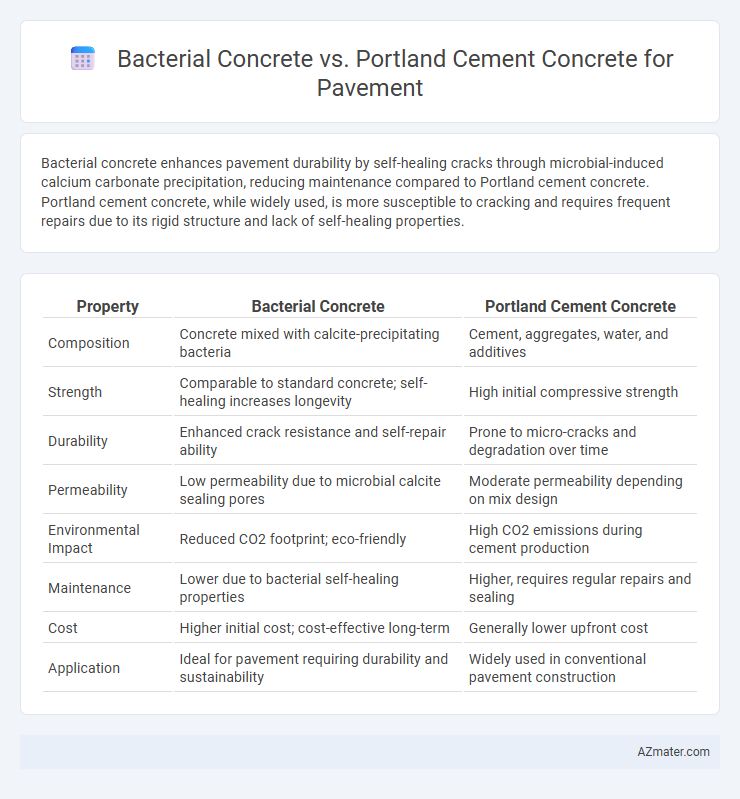Bacterial concrete enhances pavement durability by self-healing cracks through microbial-induced calcium carbonate precipitation, reducing maintenance compared to Portland cement concrete. Portland cement concrete, while widely used, is more susceptible to cracking and requires frequent repairs due to its rigid structure and lack of self-healing properties.
Table of Comparison
| Property | Bacterial Concrete | Portland Cement Concrete |
|---|---|---|
| Composition | Concrete mixed with calcite-precipitating bacteria | Cement, aggregates, water, and additives |
| Strength | Comparable to standard concrete; self-healing increases longevity | High initial compressive strength |
| Durability | Enhanced crack resistance and self-repair ability | Prone to micro-cracks and degradation over time |
| Permeability | Low permeability due to microbial calcite sealing pores | Moderate permeability depending on mix design |
| Environmental Impact | Reduced CO2 footprint; eco-friendly | High CO2 emissions during cement production |
| Maintenance | Lower due to bacterial self-healing properties | Higher, requires regular repairs and sealing |
| Cost | Higher initial cost; cost-effective long-term | Generally lower upfront cost |
| Application | Ideal for pavement requiring durability and sustainability | Widely used in conventional pavement construction |
Introduction to Pavement Materials
Bacterial concrete incorporates microbial-induced calcite precipitation to enhance durability and self-healing properties, reducing crack propagation in pavement structures. Portland cement concrete, a traditional pavement material, relies on hydraulic cement chemistry to achieve strength and load-bearing capacity but is prone to cracking and requires maintenance. The integration of bacterial agents in concrete formulations presents a sustainable alternative by improving longevity and reducing environmental impact compared to conventional Portland cement concrete.
Overview of Portland Cement Concrete
Portland cement concrete for pavement consists mainly of cement, aggregates, water, and admixtures, forming a durable and strong material widely used in roadway construction. It offers high compressive strength, excellent load-bearing capacity, and good resistance to environmental factors, making it suitable for heavy traffic applications. However, Portland cement concrete is prone to cracking and requires maintenance over time due to shrinkage and thermal expansion.
What is Bacterial Concrete?
Bacterial concrete is a bio-enhanced construction material that incorporates specific bacteria capable of precipitating calcium carbonate, which helps in self-healing cracks and improving durability. Unlike Portland cement concrete, bacterial concrete enhances the structural integrity of pavement by reducing permeability and increasing resistance to environmental degradation. This innovative technology uses microorganisms such as Bacillus species, which can survive in harsh concrete environments and induce calcite precipitation within micro-cracks, prolonging the service life of pavement structures.
Mechanism of Self-Healing in Bacterial Concrete
Bacterial concrete incorporates specific strains of bacteria, such as Bacillus subtilis, that precipitate calcium carbonate to autonomously seal cracks, enhancing durability and reducing maintenance in pavements. The self-healing mechanism is triggered when water and oxygen infiltrate cracks, activating dormant spores that induce biomineralization, effectively restoring structural integrity. In contrast, Portland cement concrete lacks this biological healing capacity, relying solely on passive crack-filling methods and exhibiting reduced lifespan under harsh environmental conditions.
Comparative Strength and Durability
Bacterial concrete demonstrates enhanced compressive strength and crack resistance compared to Portland cement concrete due to microbial-induced calcite precipitation that fills micro-cracks. The self-healing capability of bacterial concrete significantly improves its durability and lifespan, especially under aggressive environmental conditions, reducing maintenance costs. In contrast, Portland cement concrete often experiences degradation from freeze-thaw cycles and chemical attacks, leading to reduced structural integrity over time.
Crack Resistance and Self-Repair Capabilities
Bacterial concrete demonstrates superior crack resistance and self-repair capabilities compared to Portland cement concrete in pavement applications due to the incorporation of calcite-producing bacteria that precipitate calcium carbonate, effectively filling microcracks. The enzymatic activity within bacterial concrete promotes autonomous healing, enhancing durability and reducing maintenance costs. Studies reveal bacterial concrete can heal cracks up to 0.5 mm wide, significantly exceeding the limited self-repair capacity of traditional Portland cement concrete.
Environmental Impact: Bacterial vs. Portland Cement Concrete
Bacterial concrete significantly reduces carbon emissions by utilizing microbial-induced calcite precipitation to heal cracks, enhancing durability and extending pavement lifespan compared to traditional Portland cement concrete. Portland cement production emits approximately 8% of global CO2, contributing heavily to greenhouse gas accumulation and environmental degradation. Incorporating bacterial concrete in pavement construction offers a sustainable alternative by lowering maintenance needs and minimizing ecological footprint over time.
Economic Analysis and Cost Implications
Bacterial concrete offers potential cost savings over Portland cement concrete by reducing maintenance expenses through self-healing properties that extend pavement lifespan. Initial material costs for bacterial concrete may be higher due to the incorporation of specific microbial agents, but lifecycle economic analysis indicates lower overall expenditure by minimizing crack repair and rehabilitation frequency. Economic evaluations demonstrate that bacterial concrete can offer improved long-term cost efficiency in pavement applications compared to conventional Portland cement concrete.
Practical Applications in Pavement Construction
Bacterial concrete enhances pavement durability by self-healing micro-cracks through microbial-induced calcium carbonate precipitation, reducing maintenance frequencies compared to traditional Portland cement concrete. Its improved resistance to freeze-thaw cycles and chemical attacks makes it suitable for high-traffic and harsh environmental conditions in pavement construction. Portland cement concrete remains widely used due to established performance, cost-effectiveness, and ease of availability, but bacterial concrete offers promising advancements for extending pavement lifespan and sustainability.
Future Prospects and Recommendations
Bacterial concrete, enriched with microbial-induced calcite precipitation, offers promising durability and self-healing properties that may revolutionize pavement longevity compared to traditional Portland cement concrete, which is prone to cracking and environmental degradation. Future prospects emphasize incorporating genetically engineered bacteria strains to enhance calcite production, reduce carbon footprint, and improve resistance to wear and chemical attack in road pavements. Recommendations include large-scale pilot projects to optimize bacterial concentration, integration with sustainable materials, and cost-benefit analyses to accelerate adoption in infrastructure development.

Infographic: Bacterial concrete vs Portland cement concrete for Pavement
 azmater.com
azmater.com